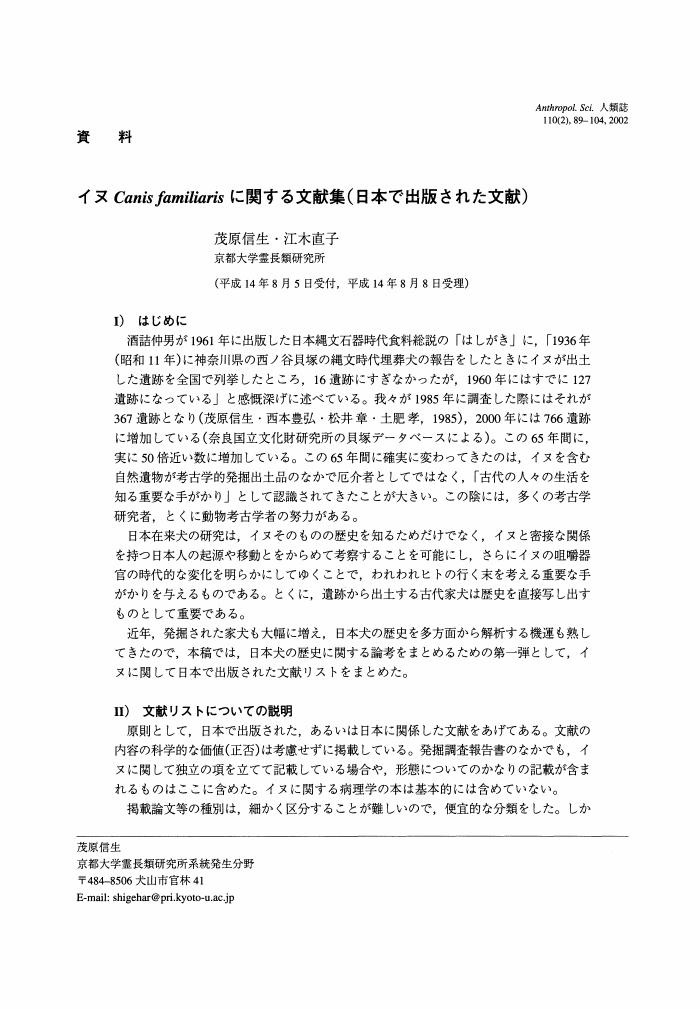8 0 0 0 OA 霊長類の手の構造: 樹上生活における把握能力の意義
- 著者
- 江木 直子
- 出版者
- 一般社団法人 日本霊長類学会
- 雑誌
- 霊長類研究 (ISSN:09124047)
- 巻号頁・発行日
- vol.20, no.1, pp.11-29, 2004 (Released:2005-05-27)
- 参考文献数
- 75
- 被引用文献数
- 2
Hand grasping is one of the unique characteristics of primates. This study reviews our current understandings on hand shape and grasping from two aspects: changes of hand structure in the fossil record, and the significance of hand grasping in arboreal life.Plesiadapiformes, the sister group of modern primates, exhibits reduction of the relative lengths of matacarpals and distal phalanges within the manus and possesses a widely divergent hallux.The transformation of nails from claws on the all fingers and the appearance of opposability in the hallux occurred after the acquisition of these morphologies. Early in Euprimate evolution, strepsirhines are characterized by wider inter-digit-ray angles and proportionately shorter metacarpals, while haplorhines have nearly parallel metacarpals associated with the development of mesaxony. The latter is more similar to the ancestral condition of Euprimates based on comparisons with other mammals .The unique characteristics of primates were explained in ambiguous terms as arboreal adaptations ("arboreal theory") until the 1960′s.Subsequent hypotheses, "visual predation theory" and "angiosperm theory", have attempted to correlate these characteristics with specific arboreal activities. It was proposed that hand grasping ability evolved in the primate ancestor because it was beneficial for stabilizing the body and for accomplishing predation at terminal branches. This explanation is based on hand grasping behavior that is also employed by some extant non-primate mammals that make use of terminal branches. Comparisons with other arboreal mammals which have grasping hands and with mechanical models have shown that longer proximal and middle phalanges and shorter distal phalanges relative to metacarpals are required for grasping narrow branches. The fact that the phalangeal ratio change occurred prior to other structural changes typically advanced as critical features in primate evolution clarifies the importance of these characteristics in acquisition of hand grasping ability, a feature that evolved in Plesiadpiformes approximately 55 million years ago.
3 0 0 0 OA 東ユーラシアにおける新生代後半の霊長類進化に関する古生物学的研究
1 0 0 0 OA イヌ Canis familiaris に関する文献集(日本で出版された文献)
- 著者
- 茂原 信生 江木 直子
- 出版者
- 一般社団法人 日本人類学会
- 雑誌
- Anthropological Science (Japanese Series) (ISSN:13443992)
- 巻号頁・発行日
- vol.110, no.2, pp.89-104, 2002 (Released:2008-02-26)
1 0 0 0 OA ミャンマー中部の新第三系イラワジ動物相:食肉目
- 著者
- 江木 直子 荻野 慎諧 高井 正成
- 出版者
- 日本古生物学会
- 雑誌
- 化石 (ISSN:00229202)
- 巻号頁・発行日
- vol.104, pp.21-33, 2018-09-30 (Released:2019-04-03)
We report occurrences of carnivorans from the Irrawaddy beds in central Myanmar. Intensive expeditions in the recent decade improved understandings on biostratigraphic position of each fauna within the Irrawaddy beds (Late Miocene to Early Pleistocene) and brought out discovery of carnivoran specimens. An amphicyonid has been collected from the Tebingan locality, near the basal horizon (Late Miocene) of the Irrawaddy beds. This large animal is considered to be a new genus endemic to Myanmar. The Chaingzauk fauna (around the Miocene/Pliocene boundary) yields the most abundant remains: An ailurid (Simocyon), a large ursid (Agriotherium), a saber-tooth felid (Homotherium), at least three species of hyaenids including a primitive subfamily member (Ictitherium), a running form (Hyaenictis), and a wolf-like form (Hyaenictitherium). The fauna consists of medium to gigantic forms; sampling biases seem to influence collection of carnivorans as well as those of other mammals. All of these carnivoran genera have cosmopolitan distributions, and the occurrences from Myanmar fill their geological gap at Southeast Asia within Eurasia. Additionally, an indeterminate feliform was collected from the fauna. The Gwebin fauna (Late Pliocene) include a herpestid (Urva), a medium-sized felid, and a viverrid (Viverrinae). This first record of herpestid in the Pliocene of Asia confirms that the extant Asian mongoose lineage had already dispersed into Southeast Asia from South Asia by the Late Pliocene. Postcranial materials from the Sulegon area (Pliocene) provide evidences of additional taxa, a small felid and a large hyaenid. These recently collected carnivoran specimens revealed presence of diverse carnivorans from the Irrawaddy faunas. They fill geographical and/or chronological gaps of carnivoran distributions in Southeast Asia. Furthermore, the comparisons among carnivoran assemblages indicate faunal turnover of carnivorans at the family or subfamily level from the Late Miocene to the Late Pliocene of Myanmar.
1 0 0 0 OA 有胎盤類における距骨cotylar fossaの保持についての機能的および系統的意義
- 著者
- 江木 直子
- 出版者
- 日本霊長類学会
- 雑誌
- 霊長類研究 Supplement 第29回日本霊長類学会・日本哺乳類学会2013年度合同大会
- 巻号頁・発行日
- pp.153, 2013 (Released:2014-02-14)
距骨の cotylar fossaは,距骨体の内側面から距骨頸にかけて形成される窪みで,アフリカ獣類などの哺乳類で知られている.この形質には収斂が認められているが,樹上歩行,地上歩行,跳躍,掘削など様々な運動行動モードを持った動物に現れるため,機能的な観点からは注目されてこなかった. cotylar fossaには脛骨遠位部の内側踝が接し,踝側の凸面が距骨側の凹面にはまって,球関節になる.cotylar fossaを持たない食肉類,齧歯類,偶蹄類などの脛骨-距骨関節は,距骨体内側面が垂直に内側踝正中面と接し,内側踝は脛骨が距骨に対して正中側にずれるのを防ぐ構造をしている.これに対し,内側踝-cotylar fossaが球関節になっている場合は,脛骨-距骨関節の滑車運動を正中側から補強している可能性がある.また,cotylar fossaがあると,脛骨から距骨への荷重伝達は,滑車関節面だけでなく,cotylar fossaの関節面である距骨体の内側壁や距骨頸でも起きると考えられる.深い cotylar fossaを持つ現生アフリカ獣類は,相対的に太い腓骨を持ち,腓骨で支えている体重の分の荷重が腓骨遠位(外側踝)から距骨体外側面へと伝達され,これを内側の cotylar fossaで受ける荷重で釣り合わせている可能性も考えられる. 深い cotylar fossaは現生哺乳類ではアフリカ獣類でのみ見られるが,化石系統群では “顆節目 ”のHyopsodontidae Apheliscinaeや南米有蹄類,肉歯目に知られている.Apheliscinaeや南蹄目,雷獣目はこの形質をもとにアフリカ獣類との近縁仮説が唱えられており,他の系統群についても同様の足根関節構造と関連する形質であるかを検討することにより,アフリカ獣類との共有派生形質であるかの評価の手段になると考えられる.
